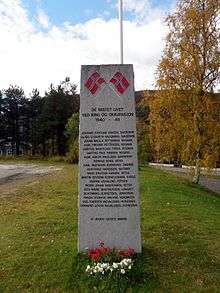Sverre Granlund
| Sverre Granlund | |
|---|---|
 | |
| Born |
9 November 1918 Sauherad, Norway |
| Died |
10 February 1943 (aged 24) Aboard HNoMS Uredd |
| Allegiance |
|
| Service/branch | Norwegian Army |
| Years of service | 1940-1943 |
| Rank | Corporal |
| Unit | Norwegian Independent Company 1 |
| Battles/wars | World War II |
| Awards | |
Corporal Sverre Granlund, DCM (9 November 1918 – 10 February 1943) was a Norwegian commando during the Second World War.
Early life and World War II
He was born in Sauherad, to a father from Øyer and a mother from Høyland.[1] He lived initially in Saltdal and later, Bodø. His job was at the Nordland Line. He was a member of the Norwegian Red Cross Youth, and served in the Norwegian Army during the Battle of Narvik in 1940.
He fled Norway for Sweden in 1941, and later continued to the United Kingdom. Here he joined the Special Operations Executive and underwent training for the Norwegian Independent Company 1.[1] His first operation was on 27 May 1941 when he set the machine room of the fish factory in Bodø on fire.
Operation Musketoon
In 1942 he participated in the commando raid against the Glomfjord generator plant in Operation Musketoon. Granlund and Cpl. Erling Djupdraet were the two Norwegians in the twelve man team, the rest of whom were British.
He and Captain Joseph Houghton had the role of scouts, ascending the Svartisen. Granlund was the only member of the team who had to kill a German, shooting a guard at the plant. After the explosions had torn apart the local dam, he sought refuge at Fykandalen, a mountain resort where he was given a map to a bridge that would lead him further up on the mountain. Unable to find the bridge by nightfall, he met up with Houghton and Sergeant Erling Djupdraet and the three returned to the resort where a scuffle broke out between the group and some Germans who had come to question the owners. After the fight, with Djupdraet wounded by a bayonet, Trigg, O'Brien, Granlund and Fairclough split off and managed to avoid capture, escaping to Stockholm, then London.
Djupdraet died on 24 September at the hospital in Bodø and of the rest, only O'Brien and Fairclough survived the war.
The distance from Bjærangfjord to Sweden walked on foot by Granlund was 250 kilometres (160 mi) and took him over seven days. A very long distance with practically no food and only wearing his uniform.
Operation Seagull
He died at sea on 10 February 1943 in transit to Norway, when the Norwegian submarine HNoMS Uredd hit a German minefield southwest of Fugløyvær, carrying his team as part of Operation Seagull.
The mines had been laid by the German minelayer Cobra and some years after the end of the war, the Royal Norwegian Navy located HNoMS Uredd in Fugløyfjord south-west of Bodø, by studying German maps of minefields along the Norwegian coast.

Legacy
Granlund was awarded Norway's highest decoration for military gallantry, the War Cross with Sword. He also received the Norwegian War Medal and the British Distinguished Conduct Medal.[1][2] In 1995, the Norwegian artist Laila Lorentzen commemorated his role in the war with a bust constructed for Saltdal Museum in Rognan.
References
- 1 2 3 Ording, Arne; Johnson, Gudrun; Garder, Johan (1949). "Granlund, Sverre". Våre falne 1939-1945 (in Norwegian). 1. Oslo: The State of Norway. p. 711. Retrieved 20 August 2011.
- ↑ Gjems-Onstad, Erik (1995). Krigskorset og St. Olavsmedaljen med ekegren (Oslo: Grøndahl Dreyer) ISBN 82-504-2190-6